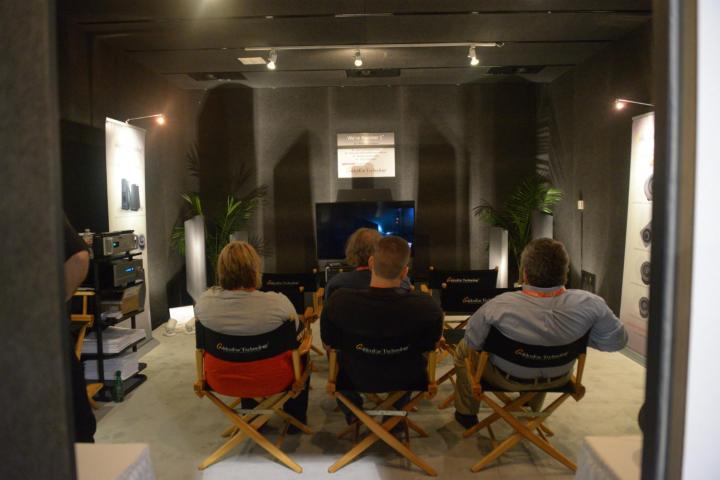
We took in a lot of demonstrations at this year’s CEDIA show, but there was one in particular that grabbed our attention, both because it was insanely ambitious, and because it was incredibly impressive. Sandy Gross, owner of a speaker company called GoldenEar Technology, pulled off the most impressive in-ceiling speaker demo we’ve ever heard, and he did it in a hastily-built “room” on the show floor of a trade show.
In-wall and in-ceiling speakers (architectural speakers) get a bad rap among audiophiles because, historically, their performance has paled in comparison to the capabilities of a traditional speaker, and because, in a way, they say something about the type of person who would own them.
“You’re not really serious about sound, are you?” they say. “Why do you want to hide your speakers? If you were a real man, you’d have speakers out for everyone to see, no matter what other people in the house think. Wait … are you seriously drinking Kombucha right now?”
Yes, it’s true: There are some who install architectural speakers because good sound takes a distant back seat to a pretty hutch or armoir. And for those of you who fall into that category, we submit to you 95 percent of the in-wall/in-ceiling speaker market. You’ve got a ton of choices, and they all pretty much sound the same. Happy shopping.
But there are some of us who want to put hard-core, THX-quality sound into a particular room where installing a conventional speaker system is completely impractical, if not impossible. Maybe there’s not enough space, or the room has a funky shape, or there are a lot of large pets around who like to tip expensive stuff over on a regular basis. Whatever the case, should we have to sacrifice awesome sound just because we have to go in-wall/in-ceiling with our speakers? Of course not! But where do you get an architectural speaker that can deliver audiophile-grade sound quality?

Back to Sandy Gross and GoldenEar Technology. We’ve known Sandy on a personal level for a couple of years now, and we’ve long been familiar with his work through Polk and Definitive Technology, both of which he co-founded. But GoldenEar Technology is a different sort of endeavor for Sandy, and we’ve found the speakers produced under this name to be something special. That is especially true for the GoldenEar Technology Invisa HTR 7000 in-ceiling and Invisa MPX in-wall architectural speakers (both of which cost $500 each), which we heard demonstrated at CEDIA.
Had we walked in blindfolded, we never would have guessed we were listening to in-ceiling speakers. First of all, the HTR 7000 provided incredibly clean and well-extended high frequencies, thanks to GoldenEar’s folded Kevlar tweeter – the same tweeter you’ll find across the company’s entire line of speakers. But secondly, and perhaps most impressively, the sound stage didn’t seem to be coming from the ceiling at all. Both dialog in movies and instrumentation in music demonstrations seemed to come from about the same level as the display, providing a realistic and naturally coherent experience.
In addition, the transition between the speakers and the two Forcefield 5 subwoofers in the demo was as seamless as we’ve heard from any subwoofer/satellite system, let alone one based on in-ceiling speakers.
Moreover, the speakers were never a distraction. They simply served to help immerse us in the movie or music experience, never calling attention to themselves, yet completely drawing us in. In our notes, we wrote: “Caught myself not listening with purpose. I just got sucked in, lost myself, and it was awesome.”
All this is to say that in-ceiling speakers don’t have to be a compromise; they can be a joy. What we heard in GoldenEar Technology’s booth is proof positive that with the right kind of engineering and attention to detail, an architectural speaker can absolutely scratch an audiophile’s itch.




